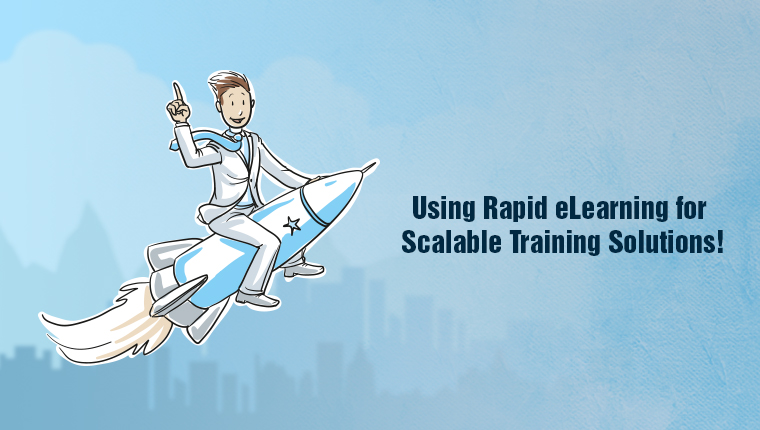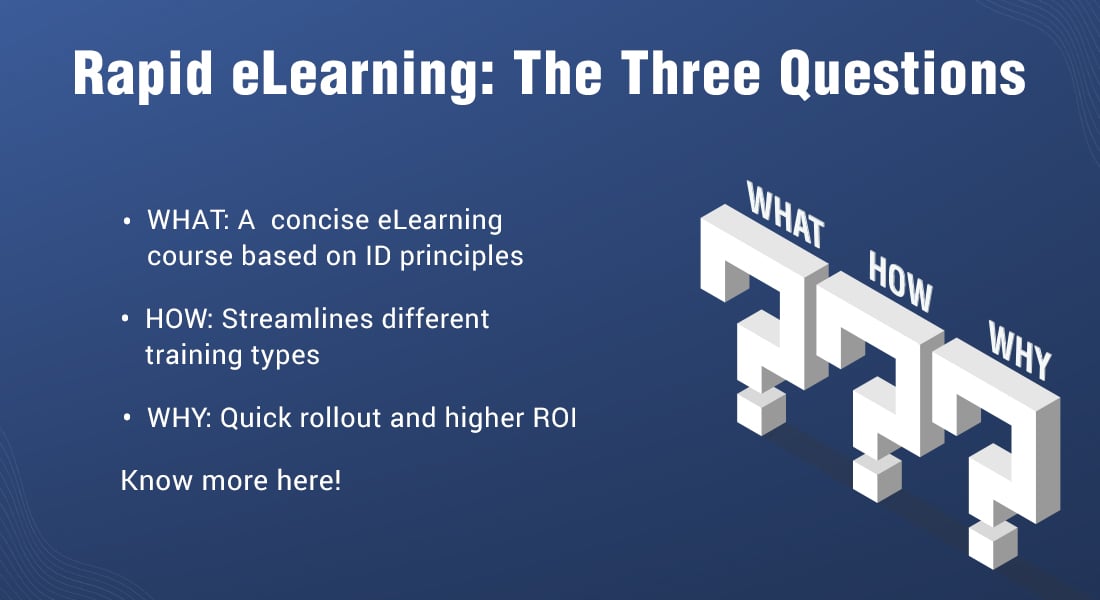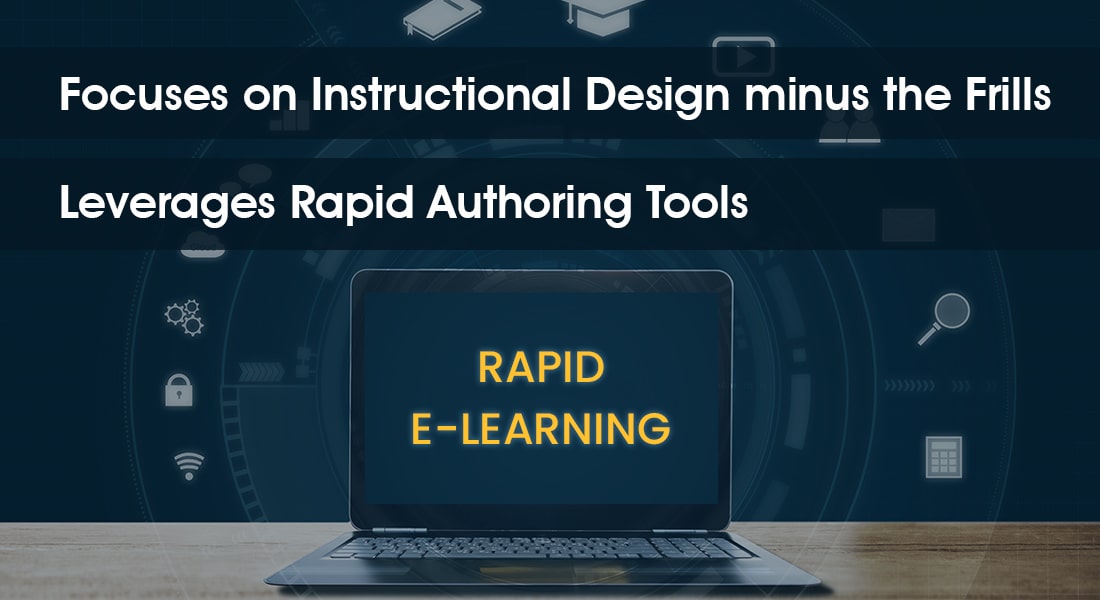A Case Study on Using Rapid eLearning for Scalable Training

I am Rapid eLearning…and this is my story! Legend has it that I was named by Josh Bersin sometime in 2003. I was further popularized by Tom Kuhlmann in his Rapid E-learning Blog and a huge credit for my growth goes to him.
An Example of Scalable Training with Rapid eLearning
Organizations looking for scalable training solutions are adopting rapid eLearning as it is very effective in crossing the barriers of time, speed, and cost. The example discussed in the blog has details on how rapid eLearning can help organizations:
- Rollout quick training solutions
- Convert text-heavy courses and make them mobile-compatible
- Design responsive eLearning
- Translate eLearning courses
Recently, one of my potential stakeholders wanted to explore the opportunity of leveraging me to design scalable training solutions. “Will rapid eLearning work?” – asked the sceptics. “Yes, it will.” – answered my proponents (one of my proponents to be precise). So, here’s the inside story on how I was used to design scalable training solutions for a stakeholder from the healthcare industry. Did I succeed? What results did I manage to achieve? Continue reading to find out for yourself.
Get complete insights on rapid eLearning.
A True Story on Rapid eLearning for Scalable Training Solutions
The Setting of the Story
An educational organization founded by physicians is committed to rolling out learning solutions to their clients in the life sciences industry. The challenges they faced were as follows:
- eLearning development had to be completed within stringent timelines
- eLearning modules had to be extremely scalable – over 870 modules had to be developed, out of which 50 courses in English had to be translated to 5 different languages
Apart from these challenges, the organization expected the rapid eLearning solution to meet the following requirements:
- Text-heavy HTML pages had to be made accessible on multiple mobile devices
- The learning experience had to be engaging and include interactivities
- Images used in the course had to be selected only from the organization’s internal image database
- eLearning courses had to be translated to the native languages of learners
The Superstar in the Story
I (Rapid eLearning) was chosen to star in this story because of what I have to offer. I am increasingly being favored by training managers across the globe because I enable:
- Quick development of training solutions
- Budget-friendly training
- Technology-enabled learning, both inside and outside the classroom
- Employee-centric learning experiences
And contrary to beliefs, I do not compromise on instructional design. While I’m certainly effective at sharing information through quick and easy training solutions, I always rely on strong instructional design principles and follow adult learning principles.
The Highlights of the Rapid eLearning Story
With stringent completion timelines being one of the main criteria that determines the success of the rapid eLearning project, it was essential that development was quick, yet cost-effective.
- Did you know that I thrive on the effective usage of templates? In order to speed up the rapid eLearning development process, developers made use of standardized templates.
- The rapid eLearning project involved the conversion of text-heavy HTML courses into ones that could be easily accessed on mobile devices. I make use of rapid authoring tools, and hence the first step involved in the conversion was the selection of the right eLearning development tool. Articulate 360 was the tool of choice.
- For rapid eLearning courses that had to be completely responsive, Articulate Rise which is part of the Articulate 360 package was used. This was particularly useful for learners who were part of the sales team, as it helped them learn on-the-go.
- SCORM-compliance of these courses was ensured so that they could be accessed seamlessly through the organization’s learning management system (LMS).
There’s a misconception that I cannot deliver when it comes to designing engaging eLearning. Let me reassure you that designing engaging eLearning is a reality with rapid eLearning.
I may not be able to offer customized interactivities that take up a lot of development time and in turn increase project cost; however, I sure can make use of interactivities in eLearning authoring tools and a dash of creative wisdom to make learning engaging. That’s exactly what was done in this eLearning project and one of the reasons it was very successful.
The eLearning Translation Story
The next section of my story involves eLearning translations of over 250 courses in 5 languages – Spanish, Russian, French, Portuguese, and Chinese. Did you know that I can be leveraged for effective eLearning translations as well?

Text from your eLearning course in English can be exported into a Word document or an XML file so that it can be translated easily. If you’re wondering how I ease eLearning translations, then with an authoring tool like Storyline, translated text can be quickly imported into the rapid eLearning course.
Storyline 360 has enhanced eLearning translation features by offering support for right-to-left languages (Arabic and Hebrew are a few examples). The tool also supports languages that use double-byte character sets (Chinese, Korean, and Japanese are a few examples).
Epilogue
Scalability and increased learner engagement were the primary goals of this project. I was brought on board to achieve this and I passed the acid test. Not just that, by taking the rapid route in eLearning development, updates to courses could be completed quickly and my proponents were able to build a successful eLearning partnership with the educational organization.
My story ends on a happy note and am looking forward to many more organizations leveraging me for gaining maximum returns on their projects without exceeding their training budgets. Have you opted for rapid eLearning in any of your projects? If you’d like to know more on best practices in rapid eLearning design, don’t forget to download our eBook – ‘Rapid eLearning Design for Quick Rollout’.





